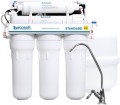Reverse osmosis
The filter has a water purification system based on
reverse osmosis.
Osmosis is the process of transition of water molecules through the so-called semi-permeable membrane — a barrier that freely passes water molecules, but retains substances dissolved in it. Usually this movement occurs from a solution with a lower concentration of impurities to a solution with a higher concentration, but there are ways to run osmosis in the opposite direction. Purification is based on this: pure water passes through the membrane, and impurities dissolved in it remain behind the barrier.
Since the separation is carried out at the molecular level, the degree of purification during reverse osmosis is very high (for example, salt water becomes fresh, not to mention the fact that the membrane does not allow bacteria to pass through). Another advantage of osmotic membranes is a long service life (see "Resource") compared to conventional filter elements: about several years, usually from 1 to 4. At the same time, reverse osmosis systems are also have disadvantages. For example, their normal operation requires a fairly high pressure, and their performance is lower than with most other filtration methods — to the point that you have to install a storage tank, which accordingly affects the dimensions. In addition, unlike other types of filtration, only about 40% of the incoming water is purified with reverse osmosis, while the rest is drained i
...nto the sewer along with the filtered impurities. As a result, this function is found mainly in sink filters and purifiers (see "Type"), where the quality of cleaning is crucial, and large volumes are not required.Pollution clipping
The smallest size of foreign particles (in microns) that the filter can hold in total. Accordingly, the smaller this size, the higher the filtration efficiency, the less undissolved impurities remain in the filtered water. On the other hand, finer cleaning usually takes more time, which affects the speed (throughput) of the filter. It should be noted that in the case of using reverse osmosis filters, the filtration is very fine, up to 0.01 microns.
Water mineralization
The presence of a
water mineralizer in the filter design. The mineralizer is usually a container filled with a special slowly dissolving mixture. Thanks to it, filtered water is saturated with various micronutrients: calcium, potassium, fluorine, ferrous (of course, not harmful colloidal ferrous, but another easily digestible form) and others. They have a positive effect on the human body and improve the taste of the water itself compared to completely purified water.
Mineralizers are found mainly in filters equipped with reverse osmosis systems (see above): the fact is that during the operation of such systems, not only harmful impurities are removed from the water, but also the mentioned micronutrients that got there naturally.
Min. operating pressure
The lowest inlet water pressure at which the filter is able to fully perform its functions. Indicated for models with a connection to the water supply — directly or through a tap (see "Connection").
The design of some filters requires a certain level of inlet pressure for normal operation; if the pressure is insufficient, both throughput and overall filter efficiency suffer, and some functions are not available at all. The latter is especially true for reverse osmosis (see above). Therefore, if the minimum operating pressure is directly indicated in the filter characteristics, you should make sure that your water supply system complies with this parameter before purchasing.
Note that for filters with a booster pump, this column indicates the lowest pressure at which the filter still does not require the use of a pump; see "Pump" for details.
Max. operating pressure
The highest inlet water pressure at which a filter connected to a tap or water supply can operate indefinitely (at least until the resource is exhausted, see above) without breakdowns, failures, etc. In other words, this is the ultimate strength of the filter. Therefore, this parameter has a great importance, and when choosing a filter, you must make sure that it meets the characteristics of the connection point. In this case, it is best to choose a model with a margin: although the device will not break from short-term pressure surges in excess of the working device, but this will create off-design loads and can lead to early failure.
When buying a filter for ordinary domestic use, it can be assumed that the maximum pressure in the water supply, provided for by the housing and communal services standards of most post-Soviet countries, represents 6 atm, but its actual value is usually lower. Therefore, 6 atm filters are quite suitable for the definition of a “model with a margin” for apartments with medium and especially low water pressure.
Tank volume
The capacity of the reverse osmosis tank. The higher the value, the more water can be filtered for future use. Popular sizes include
a 12 L tank and
a 15 L tank. Only in this case the dimensions for installing the filter will become larger. Accordingly, more is not always better. And yes, it affects the price.

